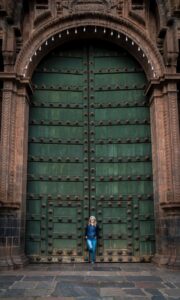Main Square of Cusco City
 In Inca times it was called «Aukaypata», a Quechua word that means place of the warrior. It was an important ceremonial place where the Inti Raymi or Festival of the Sun was celebrated every year. It was the place where Francisco Pizarro proclaimed the conquest of Cusco. With the arrival of the Spaniards, the square was transformed as stone arches were built and the constructions that surround it until today were erected.
In Inca times it was called «Aukaypata», a Quechua word that means place of the warrior. It was an important ceremonial place where the Inti Raymi or Festival of the Sun was celebrated every year. It was the place where Francisco Pizarro proclaimed the conquest of Cusco. With the arrival of the Spaniards, the square was transformed as stone arches were built and the constructions that surround it until today were erected.
Cathedral of the City of Cusco
 The Cathedral. Visiting hours: M-F and holidays 10:00 am -18:00 pm
The Cathedral. Visiting hours: M-F and holidays 10:00 am -18:00 pm
Admission fee: Adults S/.25.00 Students S/.12.50
Its construction had two stages: first the Chapel of the Triumph was built on what was the old temple of Suntur Wasi (House of God); later the cathedral was built on the palace of the Inca Wiracocha. The Renaissance style dominates the facade and the interior, with a rich interior decoration of cedar and alder carvings. The choir and the pulpit stand out for their beauty. It conserves an important collection of paintings from the Cusco school and embossed silver objects.
Temple of the Society of Jesus
Plaza de Armas. Visiting hours: M-F 9:00 am-5:15 pm, Sat-Sun 9:00 am-11:00 am and 1:00 pm-5:15 pm
General Admission: Adults S/.15.00, Student S/. 10.00
The original temple was built in 1571 on the grounds of the old Amarucancha, palace of the Inca Huayna Capac. After the earthquake of 1650 it had to be rebuilt around 1688. The original layout and the façade are examples of the Andean baroque. The «retablo» type façade is decorated with medium height towers and its stone walls have been carefully worked. Upon entering the temple, the main altar with three bodies and Solomonic columns, the wooden pulpit and numerous Baroque, Plateresque and Churrigueresque altarpieces stand out. Among the works of art, «The Marriage of Martín García de Loyola with Beatriz Clara Coya» stands out.
San Blas Neighborhood
3 blocks from the Plaza de Armas
 It is one of the most picturesque in Cusco. Called «T’oqokachi or salt hole», it is characterized by its narrow and steep streets, and its beautiful colonial style houses. It is known as the Artisans’ Neighborhood because here you can see numerous museums, workshops, handicraft stores as well as presentations of typical dances and live music on weekends in its central square. San Blas has many families who offer accommodation in their homes.
It is one of the most picturesque in Cusco. Called «T’oqokachi or salt hole», it is characterized by its narrow and steep streets, and its beautiful colonial style houses. It is known as the Artisans’ Neighborhood because here you can see numerous museums, workshops, handicraft stores as well as presentations of typical dances and live music on weekends in its central square. San Blas has many families who offer accommodation in their homes.
San Blas Temple
San Blas Square. Visiting hours: M-F 09:00 am-18:00 pm.
Admission: Adults S/.10.00 Students S/.5.00
Founded in 1560 during the Colony, it conserves a baroque pulpit that constitutes a masterpiece of woodwork and carving, attributed to the indigenous artist Juan Tomas Tuyru Tupac. www.cuscovirreinal.com
Temple and Convent of La Merced
Calle Mantas N°121 Visits: M-S 8:00 am-12:30 pm and 14:00 pm-17:30pm.
Admission: Adults S/.6.00 Students S/.3.00
The temple, of baroque style, was built between 1657 and 1680. The sacristy keeps its most precious treasure, an impressive gold and precious stone monstrance of 1.3 meters high and 22 kg of weight, crowned by a great pearl in the shape of a mermaid, considered the second largest in the world.
Temple and Convent of Santo Domingo / Qorikancha
Plazoleta Santo Domingo s/n Visits: Mon-Sun 08:30 am-17:30 pm / Sun and Holidays 14:00 pm-17:00 pm.
Admission: Adults S/.10.00 Students S/.5.00
The Qorikancha, according to the chroniclers, was one of the most impressive buildings of the Inca Cusco; it had entire walls covered with gold sheets, because it was the main temple of the Sun God.
The Spaniards built on top of the original construction, around 1534, the church and the Dominican convent, which collapsed as a result of the earthquake of 1650 and were rebuilt around 1681. The convent has a very valuable art gallery with canvases from the 17th and 18th centuries. www.qorikancha.org
Santa Catalina Temple and Convent
Santa Catalina Angosta Street s/n. Visits: During mass time.
They were built in the year 1605 on the old Acllahuasi or «House of the Chosen» (the acllas were women dedicated to special tasks for the Inca). Its architecture corresponds to the last stages of the Renaissance and is characterized by its Roman style arches. In the interior you can still see the traces of the original construction. It has an exhibition room with mural paintings, works in goldsmithing, textiles, sculptures and altarpieces.
Museum of Santa Catalina
Calle Santa Catalina Angosta N°401 Visits: Mon-Sun 08:30 am-17.30 pm / Sun 14:00 pm to 17:00 pm
Admission fee: Adults S/.8.00 Students S/.4.00
Exhibitions of paintings, textiles, wood carvings and colonial altarpieces. The pieces that stand out are the paintings of Diego Quispe Tito and the carpet of the gallery of the Arcades, in addition to religious ornaments with gold thread.



